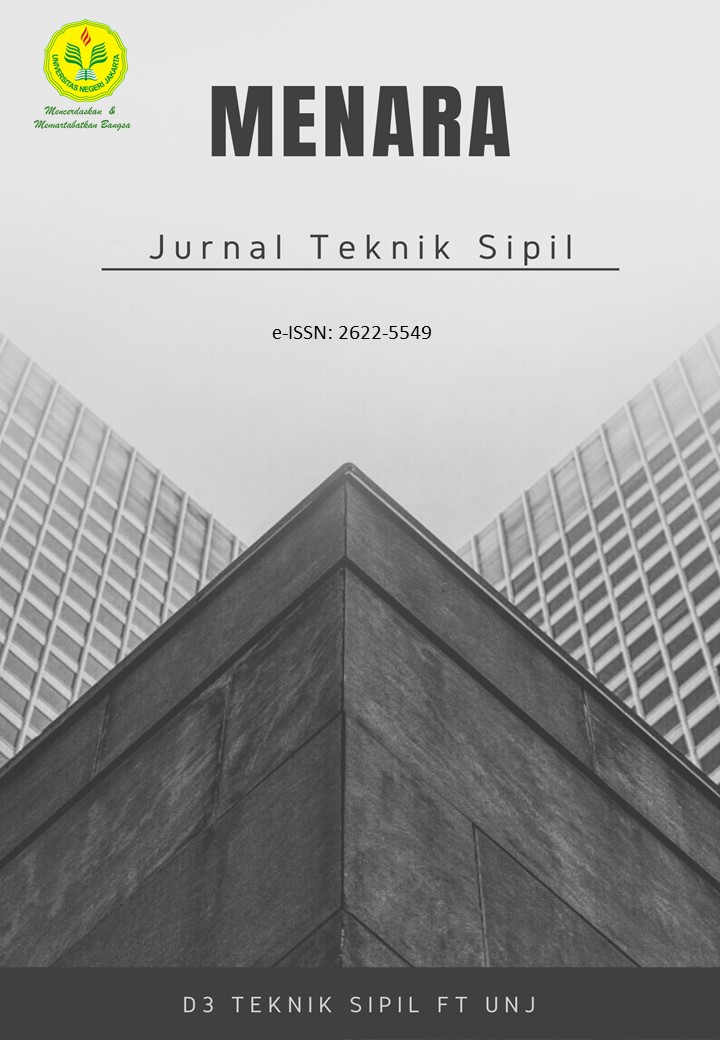Analisis Perilaku Struktur Bangunan Terhadap Beban Gempa Pada Bangunan Soft Second Story Dengan Variasi Ketinggian Kolom
DOI:
https://doi.org/10.21009/jmenara.v13i2.18923Keywords:
Vertical irregularity soft story, dynamic analysis response spectrum, base shearAbstract
The purpose of this research was to analyze soft second story bulding behavior due to the earthquake load by applying column height variation. The building case has a vertical irregularity soft story on the second level so the behavior during the earthquake was analyzed by heighten the columns at the second level of the building. The behavior of building structure results the response such as internal forces in columns and beams, base shear, fundamental period, displacement and story drift. The seismic analysis is using dynamic analysis response spectrum based on SNI 1726:2012 and carried out using software ETABS version 9.7.4. The results of this research indicates that the increase of column height in soft second story building reduces the building stiffness. So it decreases the building forces, extending the fundamental period, decreasing the base shear, increasing the displacement and the story drift. It can be concluded that the soft second story building reduces the building resistance of earthquake load by produces the behavior approaches the collapse.
References
Badan Standarisasi Nasional. 2012. Standar Perencanaan Ketahanan Gempa untuk Struktur Bangunan Gedung dan Non Gedung, SNI 03-1726-2012. Jakarta: Departemen Pekerjaan Umum.
Badan Standarisasi Nasional. 2013. Perencanaan Pembebanan untuk Rumah dan Gedung, SNI 03-1727-2013. Jakarta: Departemen Pekerjaan Umum.
Bhusnar, D. L., Pise, C., Mohite, D., Pawar, Y., Kadam, S., & Deshmukh, C. (2016). Study of different infill material on the seismic behaviour of multi-storey building with soft storey study of different infill material on the seismic behaviour of multi-storey building with soft storey. 2.
Budiono, B., & Wicaksono, E. B. (2016). Perilaku struktur bangunan dengan ketidakberaturan vertikal tingkat lunak berlebihan dan massa terhadap beban gempa. Jurnal Teknik Sipil, 114.
Contessa, E. (2008). Buku Merancang Rumah di Area Gempa. Jakarta.
Cornelis, R., Bunganaen, W., & Umbu, B. H. (2014). Analisis perbandingan gaya geser tingkat, gaya geser dasar, perpindahan tingkat dan simpangan antar tingkat akibat beban gempa berdasarkan peraturan gempa SNI 1726-2002 dan SNI 1726-2012. Jurnal Teknik Sipil, 207.
Fakhrurrazy, Manalip, H., & Windah, R. S. (2015). Analisis dinamis bangunan bertingkat banyak dengan variasi persentase coakan pada denah struktur bangunan. Tekno vol.13, 10.
Halde, V. V., & Deshmukh, A. H. (2016). Soft storey effect on structural response of high rise. 2.
Indarto, H., Cahyo, H. T., & Adi Putra, K. C. (2013). Aplikasi SNI Gempa 1726:2012 for Dummies. Semarang: Teknik Sipil UNNES.
Ismanto, I. (2009). Dasar-dasar Perancangan Bangunan Tahan Gempa untuk Arsitek Desainer. Jakarta: Arsitektur FT UKI.
Maer, B. W. (2002). Gempa Bumi, Pengaruhnya Terhadap Tampilan Bangunan. Surabaya: Universitas Kristen Petra.
Manalip, H. (2015). Analisis dinamis portal bertingkat banyak multi bentang dengan variasi tingkat (Storey) pada tiap bentang. Tekno Vol.13, No.63.
Muto, K. (1987). Analisis Perancangan Gedung Tahan Gempa. Jakarta: Erlangga.
Paulay, T.,& Priestley, M. (1992). Seismic Design Of Reinforced Concrete And Masonry Building. New York: John Wiley & Sons Inc.
Pawirodikromo, W., 2012. Seismologi Teknik & Rekayasa Kegempaan.Pustaka Pelajar. Yogyakarta.
Riza, M. (2006). Perencanaan Struktur Gedung Swalayan RAMAI Semarang. Semarang: Universitas Diponogoro.
Sadero, A. A. (2011). Evaluasi dan Perbaikan Struktur Bangunan Eksisting dengan Metode Peningkatan Kinerja Elemen untuk Memenuhi SNI 03-1726-2002 dengan Studi kasus Gedung X Jakarta. Jakarta: Teknik Sipil Universitas Indonesia.
Schodeck, D. L. (1998). Structures. Refika: PT Refika Aditama.
Schueller, W. (1989). Struktur Bangunan Bertingkat Tinggi. Bandung: PT Eresco Bandung.
Shailendra, S., & Babulal, V. H. (2015). Seismic response of soft storey on high rise building frame.
Smith, B. S., & Coull, A. (1991). Tall Bulding Structures : Analysis and Design. United States: John Wiley & Sons, Inc.
Suryanto, B. (2014, Desember 19). Software ETABS, Software Analisis Struktur Pilihan untuk Struktur Gedung. Dipetik Maret 25, 2017, dari Cerita Engineer : http://ceritaengineer.blogspot.co.id/2014/12/software-etabs-software-analisis.html
Tamara, M. (2011). Evaluasi kerusakan bangunan akibat beban gempa. 2.
Tosari, D. S., Hunggurami, E., & Pah, J. J. (2016). Pengaruh dinding pengisi pada tingkat dasar bangunan tingkat tinggi terhadap terjadinya mekanisme soft story. 2.
Yehezkiel, H. M., Wallah, S. E., & Windah , R. S. (2014). Analisis pushover pada bangunan dengan soft first story. 1.
Published
Issue
Section
License
Authors who publish with this Journal agree to the following terms:
- Author retain copyright and grant the journal right of first publication with the work simultaneously licensed under a creative commons attribution licensethat allow others to share the work within an acknowledgement of the work’s authorship and initial publication of this journal.
- Authors are able to enter into separate, additional contractual arrangementfor the non-exclusive distribution of the journal’s published version of the work (e.g. acknowledgement of its initial publication in this journal).
- Authors are permitted and encouraged to post their work online(e.g. in institutional repositories or on their websites) prior to and during the submission process, as it can lead to productive exchanges, as well as earlier and greater citation of published works.











